Unique examples discovered in the Malton Museum collection
Among the items added to the displays in the museum in 2022 was a selection of medieval shield-shaped lead weights from the Jim Halliday metal detecting collection.
A visitor to the museum, Robert Tye of Scarborough, drew our attention to these weights in general and to one unique type of design in particular. We are grateful to him for supplying the information and references on which this page is based.
There is very little historical documentary evidence about shield-shaped weights, so their origins, dates and intended purpose are all uncertain. However, in more recent times there have been two publications which have considered various aspects of these weights:
-
- “Lead Weights: The David Rogers Collection”, a book by Norman Biggs and Paul Withers, published in 2000: this includes a section on shield-shaped weights based on more than 50 examples from the Rogers collection; the authors identify five “standard” types of design (three lions passant, quartered shield, single lion, crowned lys and lys) and a range of “non-standard” types.
-
- “Yorkshire Shield Shaped Lys or Lys & Crown Lead Weights”, by Robert Tye, published in 2013: this analysed a group of 67 weights that have either of these two designs and have been found in the Yorkshire area, as listed on the Portable Antiquities Scheme Web site. This paper is available online.
Observations and theories about shield-shaped weights from these two publications are illustrated here using examples of each Biggs and Withers type from the Jim Halliday collection, all of which come from the Malton, York and Pocklington areas. Note that the Halliday collection does not include examples of the quartered shield or single lion designs.
All of the following images are to scale.
Three Lions
There are four examples of this type in the Halliday collection, including the following:
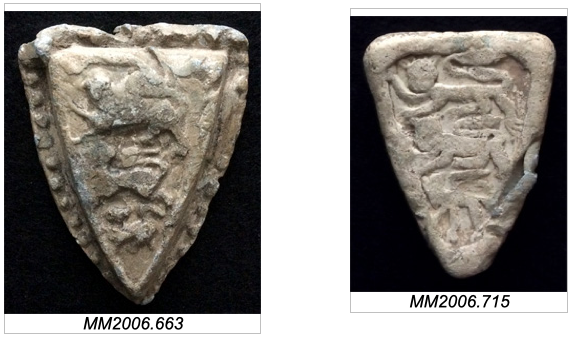
Biggs and Withers suggest that the use of the three lions design, from the arms of England, might imply that these weights belong to an official system. There were a number of attempts between the end of the 12th century and the late 14thcentury to establish a uniform system of weights, so these might represent one such system.
Although the use of the three lions design dates back as far as the end of the 12th century, it is possible that the shield-shaped weights were introduced in the second half of the 14th century when the equal-arm balance replaced the steelyard for weighing goods.
It is believed that the shield-shaped weights were in use mainly during the 15th and 16th centuries, but Biggs and Withers state there is some evidence to suggest that their use could have continued into the 17th century and possibly beyond.
MM2006.663, although a little worn, seems to have been well executed, with a raised field containing the three lions and a step decorated with pellets or “bezants”. At 218 grams this appears to be an 8 ounce weight.
MM2006.715 is somewhat worn or flattened, but it is still obvious that the design is rather more crudely fashioned. Biggs and Withers suggest that weights with designs that are less well executed might be unofficial copies of the originals, perhaps used to continue the system after it had gone out of official use. At 228 grams this appears to be an 8 ounce weight.
Crowned Lys
Biggs and Withers suggest that the use of the crown, like the three lions, might signify that the weights belong to an official system.
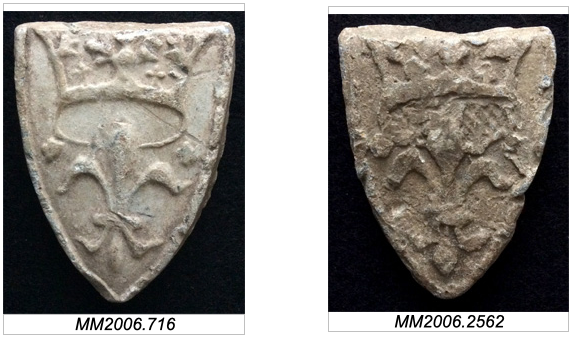
MM2006.716 is quite finely cast, and although MM2006.2562 is generally not so finely detailed, it does feature a hatched interior to the crown. Both are perhaps more likely to be official weights rather than later copies. At 226 grams and 217 grams respectively these appear to be 8 ounce weights.
The Fleur-de-Lys is these days popularly associated with France, but it was also a symbol of Florence in Italy as evidenced by the following image of a Florentine gold Florin dating from 1347. The image is a cropped version of one made available under CC BY-SA 3.0 by Classical Numismatic Group, Inc via Wikimedia Commons.
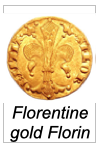
The relevance of the association between Florence and the lys will become apparent later when we come to consider the involvement of Italian merchants in the English wool trade.
Lys
There are six examples of this type in the Halliday collection, including the following:
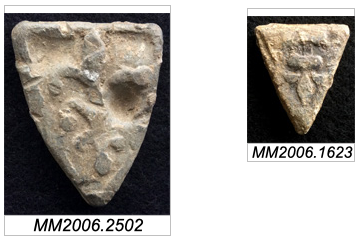
Biggs and Withers make no distinction between weights with a double lys design and those with a single lys design.
MM2006.2502. although slightly damaged, can be seen to be an example of a double lys, with one lys inverted. It’s mass of 79 grams is unusual, approximating to a 3 ounce weight.
MM2006.1623 is an example of a single lys; at 27 grams it appears to be a 1 ounce weight. Although it is more triangular than shield-shaped, Biggs and Withers include triangular weights in their category of shield-shaped weights. This example is unusual in that the single lys is inverted; Biggs and Withers have only one example of this, on a large weight with an unusual mass.
Is the absence of a crown from these weights significant? Of all the examples of weights with lys designs illustrated in Biggs and Withers and in the Halliday collection combined, it is apparent that weights of 8 ounces and above have a crown above their lys, whereas weights of 4 ounces and below with a lys do not have a crown.
It is not known whether there is a significance to the use of a single lys as opposed to a double lys, but it cannot be simply because there was not space to include two lys on the smaller weights – Biggs and Withers have an example of one of a similar size to MM2006.1623 and which has a double lys.
Non-standard Types
There are 12 examples of this type in the Halliday collection, including the following:
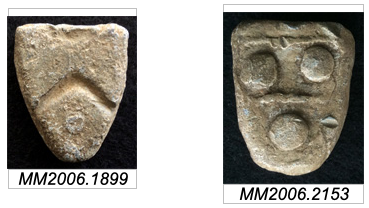
MM2006.1899 has a mass of 70 grams which is unusual, approximating to a 2.5 ounce weight.
MM2006.2153 has a mass of 112 grams and so appears to be a 4 ounce weight.
Biggs & Withers comment that chevrons and bezants (pellets) in coats of arms often date from the 15th century, so it is possible that these weights are of a similar date. Otherwise the relationship of the “non-standard” types to the “standard” types is unclear.
Crowned Rose
The Halliday collection also contains two examples of a type of design not included in the Biggs and Withers book – a crowned rose.
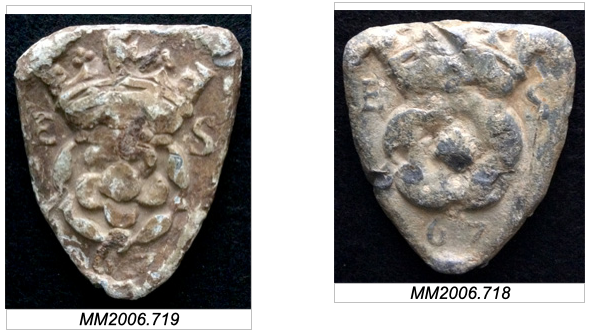
MM2006.719 is a finely cast example; at 219 grams this appears to be an 8 ounce weight.
MM2006.718 is more crudely cast; at 209 grams this is quite light for an 8 ounce weight.
Both weights can be seen to incorporate the letters “E” and “S” and the number “67”. This is thought to be the first time that clear examples of this type have been published; only one other specimen is known, and that is corroded and illegible.
This is the only type of shield-shaped weight that carries an inscription and what is possibly a date. The interpretation can only be guessed at, but the design is reminiscent of (much lighter) coin weights of the Elizabethan period showing the Tudor rose motif. The “initials” remain a mystery, but it is possible that the “67” represents the year of 1567. If so, that would represent the only clear evidence of dates for shield-shaped weights; it would also be towards the end of the period when such weights are thought to have been in use.
What is the Story of these Shield-shaped Lead Weights?
Although weights of this type survive in very large numbers it seems that they have never really been the subject of research and hence there is very little about them in the published literature. Here we will propose a possible explanation of what the weights were used for and how they came into being.
What is known for certain is that in the 13th century Italian merchants were becoming very active in the English wool trade. The Florentine merchant Francesco Balducci Pegolotti (c. 1290 – 1347) wrote a kind of almanac of world trade (La Pratica Della Mercatura), compiled in Florence between 1310 and 1340, in which he even mentions (Old) Malton in connection with the monastic wool trade:
“Maltona la buona marchi 17, e la moiana marchi 11, e i locchi marchi 6 il sacco, e annone da 45 sacca per anno”
which has been translated as:
“Malton good wool fetches 17 marks per sack, middle quality wool fetches 11 marks per sack, and poor quality wool fetches 6 marks per sack, total production 45 sacks a year”
(a mark being worth two thirds of a pound sterling).
Pegolotti also mentions Yedingham, under the name of Endicamo, in reference to the Bendictine nunnery there:
“Endicamo presso di Maltona, marchi 11 il sacco torciea”
translated as:
“Yedingham close by Malton, 11 marks per sack of rolled wool”
There are very large and very rare official-looking shield-shaped weights made of brass which very probably arose in relation to the wool trade by the early 14th century. This seems likely because most authorities agree that the c. 453 gram avoirdupois pound is actually a Florentine standard of 16 Florentine ounces. The chief English weight standards for goods prior to the wool trade were apparently the Troy pound (16 ounces = c. 497 grams) and the Tower pound (which equals 15 Troy ounces).
The shield-shaped weights made of lead tend to conform to a system in which a pound weight is approximately 440g and thus seem to be a rather poor attempt at avoirdupois, but nevertheless appear to follow the Italian system of weights of 16, 8, 4, 2 and 1 ounces. It is possible that the use of the Florentine lys design on these weights was intended to signify that they were based on the avoirdupois system.
The shape too seems to derive from the heavy brass weights associated with the wool trade. However, the most common shield-shaped lead weights seem to be the 8 ounce (227 grams) and the 4 ounce (113 grams), with two ounce (57 grams) and one ounce (28 grams) weights also being quite numerous. Examples weighing more than one pound are almost unknown. Weights of such masses seem unlikely to have been used in the trading of wool, where a sack of wool weighed about 350 pounds (about 160 kilograms).
Tye proposes that the primary purpose of the weights was in connection with the highly regulated sale of bread.
The Assize of Bread and Ale was a law, introduced in the 13th century, which set down what the weight of loaves of bread should be that cost 1 old penny, a half-penny or a farthing. The prices of the loaves were fixed, but the weight of a loaf would vary according to the price of wheat – if wheat became more expensive then loaves became smaller and vice versa. As bread is the main commodity known to have been sold by weight in the medieval period then the use of shield-shaped weights for the weighing of bread has to be a strong possibility.
Summary of Shield-shaped Weights in the Halliday Collection
The first table shows the number of weights for each design and avoirdupois mass combination.

The second table groups the shield-shaped weights by avoirdupois mass, showing for each group the number of examples along with the minimum, mean and maximum masses in the group. It does not include the two examples which appear to be 2.5 ounces or the one that appears to be 1.5 ounces.

In keeping with the findings of Tye, the second table shows that the weights generally tend to be a little lighter than they should be. Of the 26 weights, only three are more than 1 gram overweight. Whilst it is possible that some mass could have been lost from some of the weights due to wear or other damage, it seems possible that many of the weights always were lighter than they should have been. This would be hard to explain for an official system of weights that could have been carefully manufactured to small tolerances, and has to open up the possibility that these underweight examples were intended to favour the seller of goods at the expense of the buyer.
